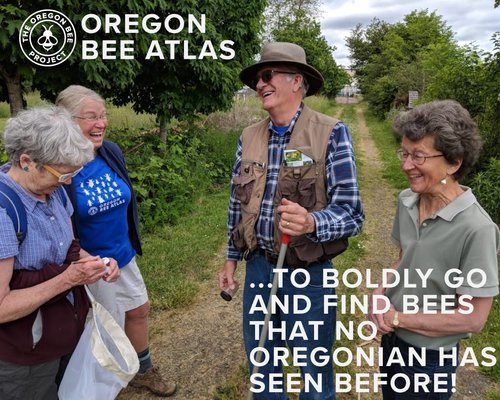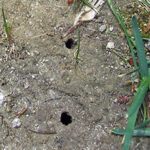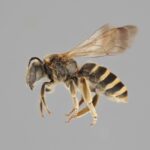When we think of bees we tend to think of them in open spaces, on flowers in the sun, busily flying from bloom to bloom.
But what about bees in the trees?
Greenbelt Land Trust member Pat Wheeler is a volunteer for the Oregon Bee Atlas, a project of the Oregon Bee Project. Pat has been exploring the presence and role of bees in and around forests.
For National Pollinator Week, we asked Pat to share some of what she has learned investigating bees in her two years as a volunteer for the Oregon Bee Atlas.

Oregon Bee Atlas volunteers, Pat Wheeler on right.
I am interested in learning more about Oregon’s flora and fauna, so I was excited when OSU’s Oregon Bee Atlas Program offered a day-long short course on Native Bee Sampling and Curation followed by a week-long course on Native Bee Taxonomy.
 My husband and I own and manage a 156-acre forest property in Benton County near Kings Valley. In addition to the forested parts of the tract we have 8-acres of wet and upland prairie that I thought would be a perfect place to sample for native bee pollinators. I have not been disappointed.
My husband and I own and manage a 156-acre forest property in Benton County near Kings Valley. In addition to the forested parts of the tract we have 8-acres of wet and upland prairie that I thought would be a perfect place to sample for native bee pollinators. I have not been disappointed.
The Oregon Department of Agriculture has a long historical involvement with the study of pollinators that play an important role in successful production of food, especially honey bees. More recently, various agencies involved in promoting healthy and productive forests have also started looking at the role native bees, not honey bees, play in Oregon forests.
At first, I was skeptical of this new interest because Oregon forests are predominantly Douglas fir, a tree that is wind pollinated and does not need an insect pollinator. After two years of volunteer work for the Oregon Bee Atlas and two years of sampling and identifying native bees on our 150-acre forest property in Benton County, I am a believer in the presence, if not the established importance of native bees in our forests.
The Oregon Bee Atlas has been featured twice on Oregon Field Guide. This Oregon State University Extension program trains and equips citizen scientists to: a) create and maintain a comprehensive and publicly accessible inventory of the state’s native bees and their plant-host preferences, b) to educate Oregonians on the state’s bee biodiversity and c) to conduct an on-going survey of native bee populations in order to assess their health.
I started these trainings in 2018 and plan to continue for at least three more years.
The best time to look for bees is April -August on calm, warm days. Bees are most abundant in young, open canopy forests and along edges and roads of older closed canopy forests. The best place to look is around any flowering plant, shrub or tree including willow, big-leaf maple, snowberry, native roses, thistles, wild strawberry, blackberries and dandelions, especially in open areas and along road edges.

Bee nest entrances.
Another place to look is low over bare ground where cuckoo bees are looking for other bee species’ nests where they can leave their eggs. You may also see pencil size holes in bare ground – these are bee nest entrances.
Four bees found on our forest property include the Western forest mason bee (Osmia nemoris), Titus’ Lasioglossum (Lasioglossum titusi), the Brown-winged furrow bee (Halictus farinosus), and the Yellow-faced bumble bee (Bombus vosnesenskii).

Western forest mason bee.
Osmia nemoris, the Western forest mason bee, is only found west of the Rocky Mountains. It is a beautiful metallic blue bee, with white hairs. It is a cavity nester and probably uses old blackberry stems and old teasel stems on our property. Flowers visited include: teasel, blackberry, dandelion, mule’s ear, Nootka rose, and clover.

Titus’ lasioglossum.
Lasioglossum titusi and Halictus farinosus are both black sweat bees with gray-white or yellow hairs. They collect salt from animal sweat, including humans, and are also only found west of the Rocky Mountains. L. titusi is a solitary ground nester and each female establishes her own nest but never sees her offspring who overwinter in the ground and emerge the following spring.

Brown-winged furrow bee.
On our property L. titusi visits dandelions, vetch, Oxeye daisies, Mariposa lilies and Oregon grape. H. farinosus is semi-social and many bees nest in close proximity. They raise two generations per season. On our property H. farinosus visits Oxeye daisies, blackberry, and Mule’s ear.

Yellow-faced bumble bee.
Bombus vosnesenskii is present in coastal California, Oregon and Washington east towards the Sierra Cascade Crest. The queens appear early in the year. Like other bumble bees, they can raise their body temperature by shivering and are thus more independent of air temperature than other bees.
Once the queen starts her colony, she stays inside and the workers appear and collect the pollen needed for raising the next generation. On our property, B. vosnesenkii visits snowberry, Mule’s ear and self-heal.
The plants listed above include native species and introduced “weeds”. We did not plant any of these ourselves. In fact, we are trying to eradicate or at least reduce some of the more aggressive plants and shrubs. Our strategy is to promote the native species and to discourage the others. Even with our weed control there is enough non-native vegetation and native vegetation to attract bees.
To learn more about native bees in Oregon, I highly recommend four video lectures posted on the Oregon Bee Atlas website under the menu The Wild World of Bees.
The Oregon Bee Atlas: Discovering a State’s Bee Fauna
She’s a Bad Bee: A Closer Look at Oregon’s Kleptoparasites
Bees in the Trees: The Search for Canopy Pollen
In conclusion, yes there are native bees in the forest, but there are many unanswered questions.
What is their ecological role? What resources do they use? Do they benefit the forest? Are the populations stable?
Stay tuned for more information as the research continues.
